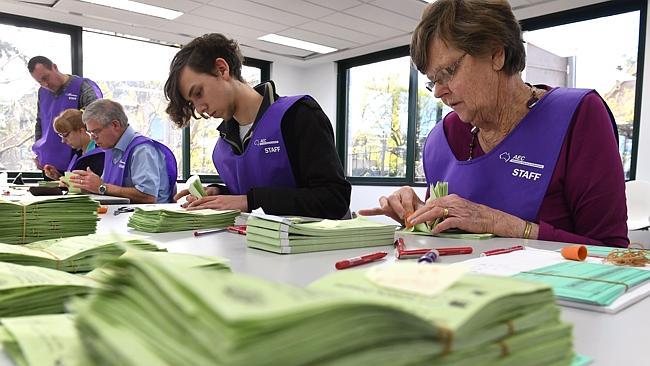With Malcolm Turnbull and Bill Shorten backing electronic voting, how would it happen in practice?
MALCOLM Turnbull and Bill Shorten have backed electronic voting to stop election delays but how do you actually cast a ballot online?

Federal Election
Don't miss out on the headlines from Federal Election. Followed categories will be added to My News.
MALCOLM Turnbull and Bill Shorten may not agree on much but there appears to be at least one subject upon which they are united: just how annoyingly long it took to work out that the bloke who was already in the Lodge would be staying in the Lodge.
Mr Shorten used his speech on Sunday, conceding Labor’s electoral defeat, to call for an investigation into electronic voting.
“I will be writing to Mr Turnbull and saying, ‘Really, we are a grown-up democracy — it shouldn’t be taking eight days to find out who has won.’
“It’s long overdue to look at electronic voting.”
Mr Turnbull said he had been an “advocate of electronic voting for a long time” and it was something he would look at.
The problem is, there has already been an investigation into e-voting in Australia and it didn’t exactly end up in a glowing seal of approval.
In fact, a 2014 parliamentary committee concluded its introduction could “catastrophically compromise our electoral integrity”.
But with the most recent election seared into the memory banks don’t be surprised if the issue is looked at again.

So, Australia doesn’t have electronic voting?
Actually, some people are already voting electronically.
In 2015, 280,000 people used NSW’s iVote system to cast their ballot in the state election. Primarily designed for people who would be unable to get to a polling station it allows people to vote online.
Does the system work?
It depends who you speak to. A team from the University of Melbourne found “severe vulnerabilities” in the system that could be used to cast multiple votes, reveal voter’s identities and subvert the verification process.
“We’ve been told repeatedly that votes are perfectly secret and the whole system is secure … and we’ve shown very clearly that’s not true,” Dr Vanessa Teague told the ABC.
The NSW Electoral Commission said it fixed any issues prior to polling day and was confident of iVote’s capabilities.

Hardly a ringing endorsement, what did the 2014 parliamentary committee say?
They weren’t brimming with enthusiasm for electronic voting either. Worried by experiences overseas, where online voting systems have been hacked, they recommended Australia stick to good old-fashioned pencils and paper.
The committee’s chair, MP Tony Smith said, “Australia is not in a position to introduce any large scale system of electronic voting in the near future without catastrophically compromising our electoral integrity.”
Despite this, electronic voting has its fans?
Absolutely. Dr David Glance, the director of the Centre for Software Practice at the University of Western Australia (UWA) admitted e-voting might not be 100 secure, but then no one ever suggested the current system was either.
“People can stroll into any polling booths without any ID, a vote is accepted and we have no idea if they are who they say they are, but those things aren’t discussed as issues and failings.”
New voting technology based on blockchain — as the UWA-based Perth start up veri.vote was developing — could be the answer.
“It has all sorts of clever aspects to it and it’s all based on cryptographic keys and the system is hard to abuse.”

What other reasons are there for introducing e-voting?
It makes voting easier and increases the number of people casting a ballot.
According to Smartmatic, a company that makes voting machines, 1.1 million young people in the UK who didn’t vote in the recent EU referendum would have done so if they could have performed the task online rather than trekking to a dusty school hall.
So, if we did vote electronically, how would we do it?
First off, there is the full online model pioneered in Estonia. Here, voters slide their ID cards into their laptops to identify themselves and then vote online following some security checks.
In the US state of Utah, Republicans party members were allowed to vote online in March for the presidential caucus. Voters were sent an online key that gave them access to the site.
But while convenient, these online voting methods alarm some politicians concerned about hackers breaking in and changing votes.
Are there other ways to electronically vote?
A halfway house is to still head to a polling place, fill in your vote and grab a sausage sanger. But the votes are counted electronically there and then so the results are almost instantaneous.
In India, the world’s largest democracy, voters cast their ballots not on paper but on electronic machines within each polling station.

What might happen in Australia?
Dr Glance thinks polling places will remain for some time to come but pencils will be gone. Instead people will vote electronically, most likely on an iPad. These might then spit out a receipt with a confirmation of the vote which would popped into the ballot box as now.
The e-result would come out as the polls close but that would then be verified against the receipts to ensure there wasn’t a glitch in the system.
Are Australians likely to accept e-voting?
Probably. A 2015 survey conducted by the University of New England’s Mobile Voting research program, revealed three quarters of people said they would consider voting online with 71 per cent saying a paper receipt, would reassure them their vote would not be tampered.
But will it happen?
It’s expensive but weighed against the cost of the masses of staff needed at counting centres it could be worth it. And, besides, if it saves Australia more than a week of uncertainly maybe it’s worth looking into.
benedict.brook@news.com.au
Originally published as With Malcolm Turnbull and Bill Shorten backing electronic voting, how would it happen in practice?



